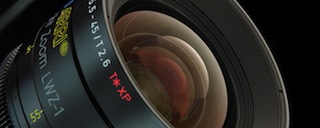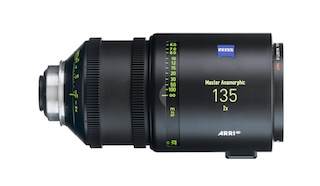 Even by itself a professional motion picture lens feels magical. Each one represents the painstaking work of many dedicated people who put their hearts and souls into the creation of a precision blend of metal and other materials encasing carefully polished glass. For nearly a century, ARRI has been putting quality tools into the hands of filmmakers, including cameras, lights and lenses. The company proudly claims to bet the largest manufacturer of motion picture equipment in the world. And the case can be made – with its groundbreaking ALEXA and other cameras – that no legacy film company has made the transition to the digital era better than ARRI.
Even by itself a professional motion picture lens feels magical. Each one represents the painstaking work of many dedicated people who put their hearts and souls into the creation of a precision blend of metal and other materials encasing carefully polished glass. For nearly a century, ARRI has been putting quality tools into the hands of filmmakers, including cameras, lights and lenses. The company proudly claims to bet the largest manufacturer of motion picture equipment in the world. And the case can be made – with its groundbreaking ALEXA and other cameras – that no legacy film company has made the transition to the digital era better than ARRI.
As much as any other manufacturer in the business, ARRI understands the dynamics in place when a cinematographer makes the decisions about which camera and lens to select for a given project and shot.
To better understand the dynamic between camera and lens and to learn how professional lenses are made Digital Cinema Report is presenting an ongoing series of conversations with the major professional motion picture lens companies. In this, part five Digital Cinema Report spoke with Thorsten Meywald, ARRI’s product manager for lenses.
Digital Cinema Report: What drives lens development at your company? Is it customer demand, products introduced by your competitors, or innovations discovered by your own designers? A combination of all of those? Something else entirely?
Thorsten Meywald: ARRI has a very long tradition in lenses starting in 1924 with the first ARRINAR lens; ARRI continues to set landmarks in lens design for cine applications. Lens series like the Standard, High Speed, Ultra Prime, Master Prime and the Alura Zooms are famous in our industry. New lens projects at ARRI are always driven by customer demands and the latest innovations. ARRI lenses are fully integrated in our system of high performance cameras and versatile accessories.
 DCR: What is the single biggest challenge in making a high quality professional lens?
DCR: What is the single biggest challenge in making a high quality professional lens?
TM: There are many challenges in making high quality lenses. ARRI’s challenges are customer driven. We aim to provide a future-proof lens system for a secure investment by our clients on a long-term basis. ARRI lenses provide perfect optics in rugged housings to make sure they never fail on set.
DCR: How much time does it take to bring a new prime lens to market?
TM: The timeline for new primes depends on the complexity of the optical design and the number of different primes. In general we are developing not just one or two different primes, we are developing complete lens sets (between 7 and 16 lenses) based on completely new optical and mechanical design principles. Sometimes it needs 5-6 years do develop a complete lens set, this includes also the pre-studies.
DCR: How much time does it take to bring a new zoom lens to market?
TM: Due to the higher complexity of zoom lenses the timeline for zoom lenses is similar to those for primes.
DCR: Describe the steps in each process, prime and zoom.
TM: At ARRI we have a very special procedure because on the one hand, we are by far the largest supplier of high-end cine lenses. On the other side, we don’t produce the lenses. It starts with market research to find out the requirements of the market. After that, we define the required specifications for the lens projects and set up the business plan. At this point we have a very precise technical description of the future product. Then we discuss the feature specs with the partner who is designing and manufacturing the lens for us. We continue with our partner through a regular design phase where we monitor the whole process (design reviews, prototype testing). Finally, the product is integrated in to our quality control system and ready for sale through ARRI’s exclusive channels worldwide.
 DCR: To what extent has digital cinematography changed lens design and manufacture?
DCR: To what extent has digital cinematography changed lens design and manufacture?
TM: The requirements for digital cinematography are higher compared to analog film. In the future, we need to address higher resolution sensors with high dynamic range. This requires lenses with tighter manufacturing tolerances and sometimes rather unusual optical designs. The minimum requirement is to meet the performance of the sensor. But this is not enough; at the same time modern lenses should also meet the aesthetic expectations of DPs.
DCR: Has there been a dramatic change in the kinds of lenses cinematographers request? If so, what?
TM: Not really. Currently, cinematographers are talking more about the style of older lenses and generating artistic flares. This might be a short-term trend. However, when we look at our sales figures there is an increased demand for modern high-performance lenses that give sharp and crisp images. Rentals and DPs want to be on the safe side having an optical system, which doesn’t fail on set.
DCR: How much of the lens-making process is still done by hand?
TM: We are always looking to establish industrial manufacturing processes to secure consistent quality on the lenses. The majority oft he process uses an industrial process, but some processes are still done by hand, depending on the production volume.
DCR: Where are your lenses made?
TM: ARRI lenses are made in Germany or in Japan.
DCR: Where do you source your glass?
TM: Also from Germany or Japan.
DCR: Will lenses always be analog or can you envision an all-digital high quality professional lens?
TM: In the future all lenses will be optimized for digital sensors. However, they will also work with film cameras.
Here are links to the first four parts in this series:
Magical Glass: Part 1, Schneider-Kreuznach http://bit.ly/UIyuIz
Magical Glass: Part 2, Canon http://bit.ly/1pPxY6R
Magical Glass: Part 3, CW Sonderoptic http://bit.ly/1rw1Kf5
Magical Glass: Part 4, FujiFilm http://bit.ly/1vhGYDe
